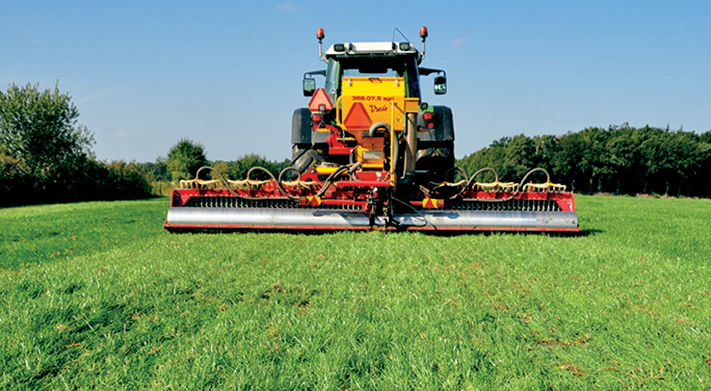A better grass-growing year starts with a timely springtime renovation
Spring is the time to repair your grassland in readiness for a season of better and more efficient production. Do it now and you'll reverse the year-by-year decline in time for the peak growing season.
06/02/2018
Put your grassland back into full production
Even on the best-managed grassland, annual output declines as weed species take hold. The forage quality also falls because weeds offer poor nutritional value – less than that of specially developed pasture grasses and clovers. Add in winter damage, and your sward could be seriously underperforming.
Renovation is the answer. If you prepare now, you could be looking forward to a summer of high-quality grass. But your approach – a new lay or overseeding – depends on the soil condition of your sward.
Overseeding is a hugely popular and highly cost-effective method of grassland renovation simply because you don't have to plough up your old sward. That makes it particularly effective for shallow soils or stony grounds that would be difficult to plough. Although overseeding is cheaper and faster, the establishment rate is less good. Reseeding is better for establishment because the new seeds don't have to compete with existing grass plants.
Guidelines for overseeding
In most of Europe, early spring or late summer is the best time for overseeding. Graze or cut your sward to 3cm to 5cm before you start. Make those cuts in the autumn if you're planning to overseed in the spring.
Harrow or rake the grass to open the sward and remove the weeds from the base of the grass. And you'll definitely need to remove them if the content of Poa trivialis is high.

Seed immediately after harrowing. Your options are:
(1) broadcast the seed by fertiliser spreader or special tine harrow with seeder or
(2) drill into the soil with a disc seeder.
The disc seeder is more reliable in drier areas because the soil covering offers your seeds some protection against the weather. For broadcasting, use a roller or stock to achieve good contact with the soil.
You can continue to graze until seedlings start to emerge, then rest the area for 4 to 5 weeks. You will, however, have to cut or graze the field if the old sward reaches 15cm to 20cm high and becomes too competitive for the new seedlings. Controlling the competitiveness of the old sward is crucial for successful overseeding. But take care not to overgraze it.
Apply P and K fertiliser according to your soil analysis, but don't use N fertiliser before sowing. Apply 30kg to 50kg N after cut first.
What to sow
Not all grasses and clovers are suitable for overseeding. Perennial ryegrass and festulolium ryegrass types are best in humid areas because they have large seeds, vigorous growth and high-quality forage. In drier areas, cocksfoot, tall fescue and festulolium tall fescue types are good for mixtures with ryegrasses. Use timothy for wet pastures.
Spring overseeding also gives you a chance to improve the clover content of your sward. Clovers produce high-quality forage and will reduce or eliminate the need for N fertilisation. Red clover is best for its quick establishment and good competitiveness with grasses. Red clover is also the first choice for conservation, and is good for both silage and grazing. White clover should be added for grazing.
And for overseeding we also recommend our ForageMax mixtures; GrassMax Original.
You are also welcome to contact your local DLF representative to get advice for your regional conditions.
